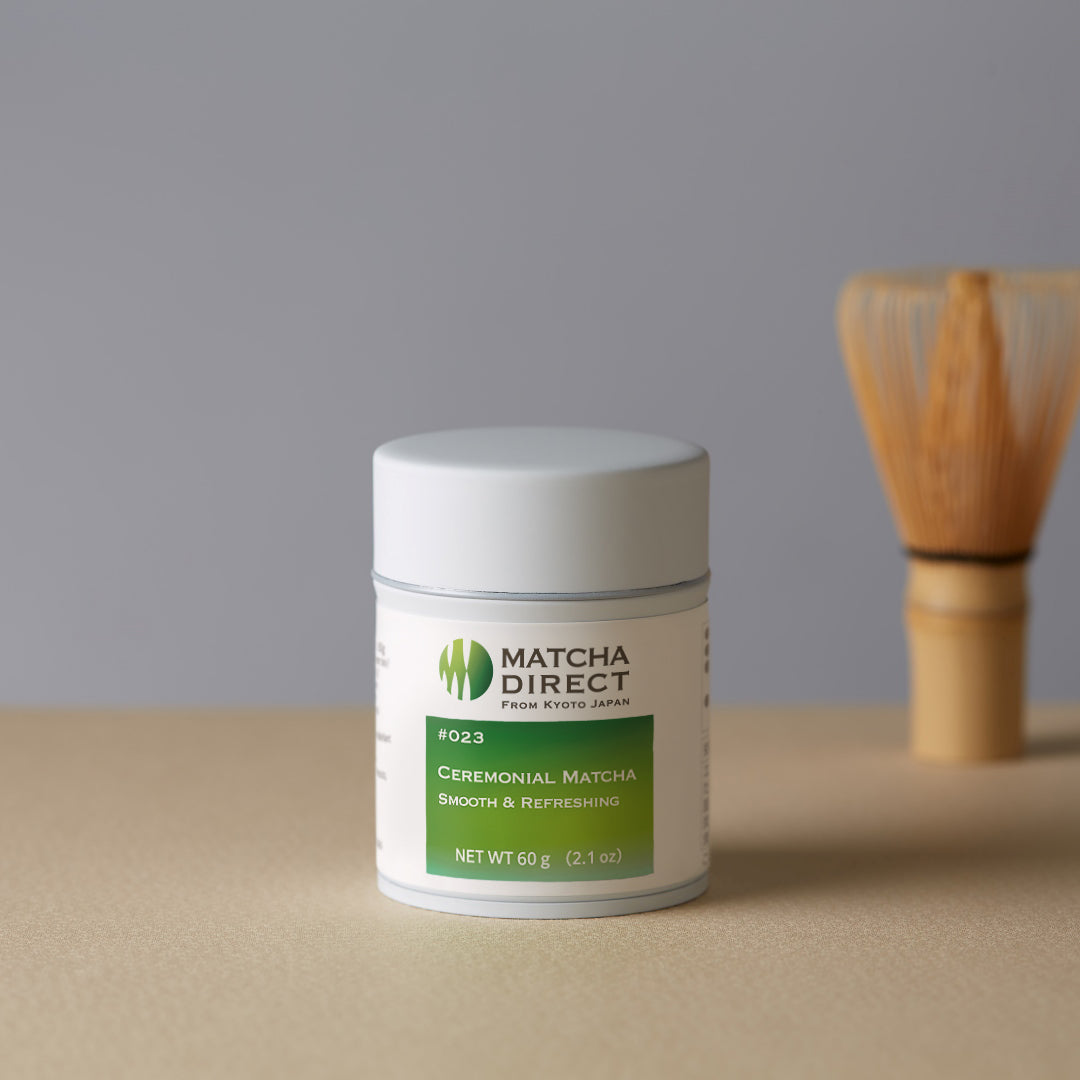Ceremonial Grade Matcha vs. Culinary Grade Matcha: What's the Difference?

Matcha, a key symbol of Japanese culture, has become popular worldwide.
Did you know that matcha comes in several grades?
This article will focus on two main types: "Ceremonial Grade Matcha" and "Culinary Grade Matcha."
These two grades are classified based on the types of tea leaves harvested, flavor, texture, and the intended use of the matcha.
By understanding the differences between Ceremonial and Culinary Grade Matcha, you can choose the best matcha to suit your lifestyle and intended use.
What is Ceremonial Grade Matcha?
First, let’s discuss Ceremonial Grade Matcha. This high-quality matcha is used in traditional Japanese tea ceremonies.
Ceremonial Grade Matcha is made using young tea leaves from the first harvest of the season, called "first flush" or "ichibancha."
Because it is made exclusively from first-flush leaves, this grade of matcha allows you to fully enjoy matcha's natural rich aroma and complex taste, making it rare and known for its high cost.
Ceremonial Grade Matcha is recognized by its vibrant deep green color and a unique aroma known as “shade-grown aroma” or ooi-ka. This characteristic fragrance results from shading cultivation, where tea leaves are shielded from sunlight while growing. Because first-flush leaves are the earliest to be harvested after shading, they deliver the strongest ooi-ka.
Shaded tea leaves also contain high levels of theanine, which gives matcha its subtle sweetness and umami flavor. This umami and sweetness, core to matcha's essence, are largely due to the presence of theanine and contribute significantly to the high evaluation of Ceremonial Grade Matcha.
What is Culinary Grade Matcha?
Culinary Grade Matcha is primarily used for cooking, baking, and in beverages.
Unlike Ceremonial Grade Matcha, which uses first-flush leaves, Culinary Grade Matcha is made from second flush leaves (nibancha) or autumn-harvested leaves (akibancha).
It has a more subdued green color than Ceremonial Grade Matcha, with a slightly coarser texture. Since it is made from leaves exposed to sunlight for a longer period, Culinary Grade Matcha contains higher levels of catechins, which contribute to matcha's bitterness.
Due to its coarse texture and bitterness, Culinary Grade Matcha may not be ideal for drinking on its own. However, these characteristics enhance the depth of flavor in culinary applications, where they bring an earthy accent to dishes and desserts.
Culinary Grade Matcha is generally more affordable than Ceremonial Grade, making it an accessible option for everyday use.
How to Use Ceremonial Grade and Culinary Grade Matcha
As mentioned, the uses of Ceremonial and Culinary Grade Matcha differ.
Ceremonial Grade Matcha is primarily enjoyed in its pure form to highlight its delicate taste, similar to the way it is prepared in traditional tea ceremonies. Drinking it without adding anything allows you to savor the inherent sweetness, umami, and slight bitterness of high-quality matcha.
However, when buying Ceremonial Grade Matcha, keep in mind that products labeled as “Ceremonial Grade” outside Japan may not always reflect the expected quality. Look for matcha marked “first flush” or “ichibancha” to ensure authentic Ceremonial Grade quality.
https://matchadirect.kyoto/products/ceremonial-grade-matcha
In contrast, Culinary Grade Matcha shines when blended with other ingredients.
When added to matcha lattes, smoothies, ice creams, or baked goods, its distinctive bitterness complements the sweetness of the recipe, creating a balanced and profound flavor profile. The bitter taste of Culinary Grade Matcha pairs exceptionally well with sweet ingredients, making it ideal for desserts.
Which is Healthier: Ceremonial or Culinary Grade Matcha?
Nutritional Value of Ceremonial and Culinary Grade Matcha
Both Ceremonial and Culinary Grade Matcha contain similar nutrients, as they both come from the same raw material, known as tencha.
https://matchadirect.kyoto/blogs/matcha-101/what-is-tencha-the-raw-material-for-matcha
Ceremonial Grade Matcha, however, retains higher levels of theanine due to shading from sunlight, which not only enhances umami flavor but is also believed to promote relaxation.
When tea leaves are exposed to sunlight, theanine converts to catechins, so Culinary Grade Matcha, which uses leaves exposed to more sunlight, tends to have a higher catechin content.
Catechins contribute to bitterness but are also known for their antioxidant properties. Among these, epigallocatechin gallate (EGCg), known for its strong antioxidant effects, is particularly abundant in matcha.
Which Grade is Better for Health?
Since both grades contain the same types of nutrients, one is not necessarily healthier than the other. Choosing between Ceremonial and Culinary Grade Matcha depends more on how you plan to use it.
For enjoying pure matcha flavor or traditional tea practices, Ceremonial Grade is ideal. For adding matcha to lattes, smoothies, or desserts, Culinary Grade is better suited.
Which Matcha is Right for You: Ceremonial or Culinary Grade?
Ceremonial Grade and Culinary Grade Matcha each have unique characteristics and purposes, but it’s not about one being superior to the other; the best choice depends on your intended use.
Both matcha types are rich in beneficial nutrients, and by selecting the matcha that aligns with your lifestyle and preferences, you can maximize its appeal. Choose the right matcha for you and incorporate it into your daily routine to experience the full allure of matcha.
Try 'MATCHA DIRECT's Ceremonial Grade Matcha
MATCHA DIRECT, operated by a traditional tea shop with over 160 years of history in Kyoto, Japan, offers high-quality Ceremonial Grade Matcha.
Our matcha is freshly ground to order, ensuring optimal freshness.
Thanks to direct sales without middlemen, MATCHA DIRECT provides top-quality Ceremonial Grade Matcha at a relatively affordable price.
Enjoy the refreshing aroma and elegant umami of matcha made from premium first-flush leaves.
https://matchadirect.kyoto/pages/all-products-for-home#ceremonial













